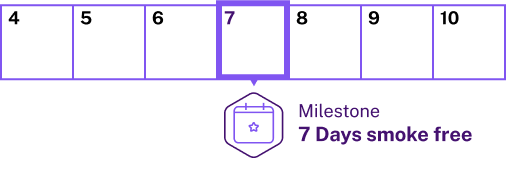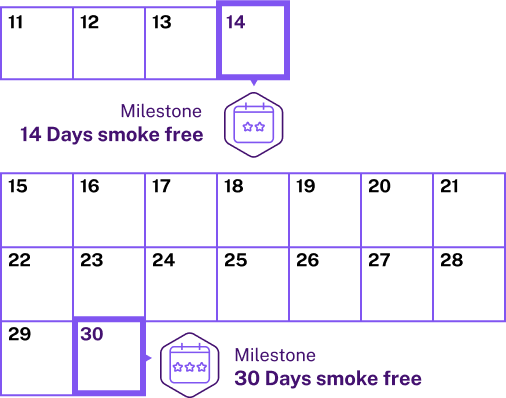Well done on taking the first step to quitting smoking!
Deciding to stop smoking is one of the best things you can do – for you and for your family and friends.
In this Quit Plan, we’ve tailored some tips for you, based on your goals and choices. You can print it out to track your progress and savings and you can use it to note how you’re feeling about cravings, triggers and more.
Remember to access available support, such as Quitline and the iCanQuit community. Your family and friends can also be a great cheer squad. Sharing your quit plan with a friend or loved one can help keep you focused on your goals.
Your Quit Plan snapshot is on the next page. It lists your start date, reasons for quitting, your triggers and goals – in short, the commitment you’ve made with yourself! You can print it out and stick it on your fridge or somewhere handy to keep it front of mind.
Your quit date
- Home
- Dashboard
- My quit plan
- Quit Plan Print
Quit Plan Print
Hi ,
Are you ready to get started?
My reasons for quitting
Based on what you told us, your reasons to quit are:
Reminding yourself of your reasons and the benefits of quitting smoking can help you stay on track and keep you motivated. If you keep your reasons front of mind, you’ll stay aware of how your decision to quit is positively impacting your life.
Take a moment for you
You’ve chosen your reasons to quit – now let’s take it one step further. Quitting is about more than stopping smoking or vaping. It’s about creating a life where you feel stronger, healthier and more in control.
Imagine your smoke-free future - what would change if you quit for good?
Up next
On the next few pages, we’ll take a closer look at the motivations and triggers you selected. We will share practical ways to prepare for those triggers and your quit day. You can come back to these pages any time you need a reminder of why you started.
Preparing to quit
Managing triggers
In certain places, with certain people, at certain times, or with certain feelings, you might be more likely to smoke. Before you quit, take time to understand what prompts you to smoke and how you feel before you smoke. Everyone’s triggers are different. You told us during your quit plan set-up that you’re usually doing the following when you smoke:
Knowing your triggers helps you stay in control
By paying attention to what your triggers are, you can make a plan to deal with them. Sometimes you can avoid them completely. Other times, you might need to face them but handle them in a new way. Below are some ideas that might help with your triggers. Not all of them will be right for you - and that’s OK. Try different ones and keep going until you find what works best.
Pre-quit checklist
Based on what you told us, we’ve come up with a list of helpful activities you can aim to complete before you reach your quit date.
If you must change it, set a new date straight away.
Prepare your support
Prepare your support
Ask for advice in the iCanQuit community
Our online forum has a loads of stories from successful quitters. Find inspiration and support for your own quit journey. Visit: icanquit.com.au/community
Prepare your quitting methods
Prepare your quitting methods
Your quit date
The day before your quit date
- Clear out cigarettes and smoking triggers: remove cigarettes, vapes, lighters, and ashtrays from your home, car, and workplace.
- Plan your quit day: keep yourself busy with activities that help distract from cravings.
- Get your quit aids ready: make sure you have your medications (NRT or prescriptions) on hand. If you have questions, call Quitline (13 7848) for advice on how to use them properly.
- Let your support system know: if you feel comfortable, tell friends, family, or your GP about your quit day so they can encourage you.

Days 1-3
Making it through day one and the next few days is a big milestone! Here’s how to make it through with confidence:
- Follow your quit plan: stick to the strategies you prepared for.
- Use your quit aids: if you’re using NRT or medication, take them as directed to manage cravings.
- Stay busy: distract yourself with work, exercise, hobbies, or social time with non-smokers.
- Recognize cravings: they will pass! Each one lasts only a few minutes. Try deep breathing, drinking water, changing tasks, or moving places.
- Lean on your support: reach out to family, friends, our great community, or Quitline (13 7848) if you need encouragement.
- Avoid temptation: stay away from smoking triggers like alcohol or places where you’d normally smoke.
- Celebrate your wins: each smoke-free day is a huge achievement and brings you closer to a healthier future. Focus on one day at a time.

Days 4-10
You’ve made it past some of the hardest days - don't stop now. Cravings may still pop up, but they won’t last forever. Use the strategies that got you this far to stay motivated and on track. Continue to lean on your supports and reach out to the community or Quitline for advice.

Days 11-30
You’ve come a long way, and your smoke-free routine is becoming more natural. Cravings may still come and go, but they’re likely shorter and less intense. Keep using the strategies that have worked for you and stay mindful of your triggers.
Here’s how to keep going strong:
- Stay focused: remind yourself why you quit and how much progress you’ve made.
- Mix up your routine: new habits help break old patterns - try a different morning routine or take up a new hobby.
- Watch for unexpected triggers: stress, social events, or even a familiar smell can bring up cravings - have a plan to handle them.
- Stay connected: check in with Quitline, supportive friends, or the iCanQuit community if you need a boost.
- Celebrate the milestone: reaching 30 days is a big deal—treat yourself to something meaningful.
Once you hit 30 days, the job isn’t over—staying quit is a long-term commitment. Keep building healthy habits, stay aware of your triggers, and remember that every smoke-free day is a success. Keep going!

Staying quit
Managing slip-ups
If you’re trying to stop smoking and have a slip-up, don’t feel like you’ve failed. Most people try to quit several times before they’re successful. Think of a slip-up as a learning experience you can draw on as you keep trying to quit. Remember: the more times you try to quit, the closer you are to succeeding. The important thing is to keep trying.

Slipping up or relapsing is a great time to review your reasons for quitting. Remember why you’re here and celebrate how far you’ve come. Ask yourself the following questions:
- Did I slip up for any particular reason or set of circumstances?
- Is there a way to avoid those situations or triggers?
- Is there a strategy I can use to help manage the situation if it arises again?
- Do I need help to manage withdrawal symptoms?

Other ways to get support
Receive tailored support to help you quit smoking and vaping, call the NSW Quitline on 13 7848 (13 QUIT) to speak to a professional counsellor.
GPs and health professionals can provide information on quitting, cravings and suitable medications. Look for the GP finder tool on our website if you don't already have a GP.
Download our free Quit Kit, available in multiple languages, that can help you plan and navigate your quit journey.

Our community has a wealth of stories from successful quitters. Find inspiration and support for your own quit journey.